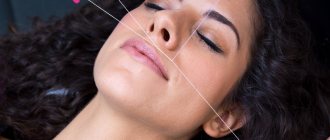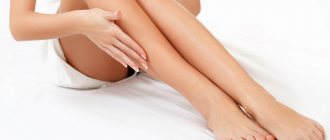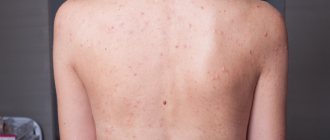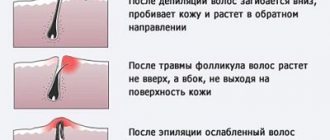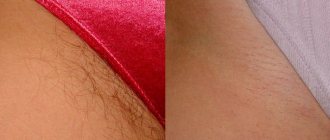Reasons for appearance
Remember! Irritation in the intimate area is the first alarm bell. This is especially true when it appears after shaving. Here you should either change the razor or seek help from a cosmetologist.
After unsuccessful depilation, it happens that the hair does not grow upward, but under the skin. Gradually it curls up into a spiral, and a capsule filled with white contents forms around it. For the body, an ingrown hair is a foreign body that the tissues try to get rid of through an inflammatory process. In this case, itching of the affected area occurs, swelling and redness appear. In the cavity of the formed cone, a hair twisted into a ring is clearly visible.
Girls with naturally thick and curly hair and dry skin with an increased tendency to keratinization often face this problem. The choice of hair removal method does not play a significant role. Incorrect growth can be caused by wax strips or sugaring, as well as a regular razor or cream with chemical components. In some people, the bulbs are located in the skin at an angle from birth, which increases the risk of ingrown hairs.
The cause is shaving too often. After the procedure, the bulb remains in place, and the hair grows weaker and thinner each time. The pores become clogged with fatty secretions and particles of unexfoliated epithelium. The hair is not able to overcome this plug or break through the epidermis, thickened from daily mechanical stress, so it grows inside into the soft tissue. Irritation of the delicate skin can also provoke inflammation.
The problem worries girls with keratosis pilaris, popularly called “goose bumps.” Pathology occurs due to heredity, hormonal imbalances or metabolic disorders in the body, vitamin deficiency. The affected area often becomes infected due to the proximity of the vagina and anus, the mucous membranes of which are home to millions of bacteria, including pathogens. If an ingrown hair in the bikini area becomes a lump with pus, it means that an infection has penetrated through microdamages.
What not to do?
Ingrown hairs on the legs, which need to be gotten rid of urgently, should absolutely not be picked out with unsanitized hands. An infection may accompany the inflammatory process, the treatment of which will be carried out in a hospital setting. In addition, scars and pigmentation may remain on the skin, which look unsightly from an aesthetic point of view.
You should absolutely not try to remove hairs by repeated depilation, sugaring or shaving. The inflammation will only intensify, and positive results will not be achieved.
The scrubbing procedure is not recommended without “fixing” it with peeling. After the manipulations, it is mandatory to apply a moisturizer to the skin. It is impossible to peel without using a moisturizer, since irritation may develop at the site of ingrowth, which will lead to a repeat process.
Don't miss the most popular article in the section: Morning exercises for those over 40, 50. Gymnastics exercises for weight loss, video lessons.
Ingrown hairs in the bikini area photo
Pharmacy products
Pharmacy products are used if ingrown hairs provoke the development of an inflammatory process.
Help eliminate inflammation:
- Ichthyol ointment. The product is applied in a thin layer to the skin. At night, the legs are covered with film. Usually one procedure is enough, but the ointment can be used again if necessary.
- 5 drops of ammonia are mixed with 5 ml of hydrogen peroxide . The solution is added to the shower gel and applied to the site of ingrown hair for 15 minutes. After a while, the product is washed off your feet.
- Salicylic lotion not only eliminates inflammation, but also removes purulent acne. To prepare, 3 ml of alcohol is dissolved in 50 ml of water and glycerin is added. The product is applied morning and evening.
- Levomekolev ointment. The constituent component is levomecithin, an antibacterial substance. Rub a thin layer of the product into the affected area. The procedure is performed three times a day. After just 2 days, a positive effect occurs.
With timely treatment and regular use of care products, getting rid of ingrown hair on your legs will not be difficult. If the inflammatory process is severe, it is recommended to consult a specialist.
Article design: Mila Friedan
How to get rid of it?
To begin with, it is important to relieve inflammation. The lump can be lubricated with any product intended for the treatment of acne. Lotions with salicylic acid, Baziron or Skinoren gels cope well with inflammation and hyperkeratosis. The tubercle can be cauterized with iodine. The main thing is that the solution does not get on the surrounding healthy skin, otherwise a burn may occur.
You should not try to pick with a needle an ingrown hair in the bikini area that has become a lump. To make the pus resolve, make a compress with Vishnevsky or Levomekol ointment at night. To do this, apply a small amount of the product to a cotton pad, apply it to the lesion and fix it with a band-aid. The procedure is repeated until the purulent contents are released. Only after this, carefully prying the hair with a sterile needle, pull it to the surface and pull it out with tweezers. The wound must be treated with an antiseptic.
First symptoms
Signs of ingrown hairs are not difficult to notice.
This unpleasant phenomenon is accompanied by:
- soreness;
- itchy skin;
- redness of the skin.
Sometimes local inflammation can develop, which leads to bright red bumps on the skin.
Often curled hair can be seen under the skin. If the hair has been shaved recently, lumps with purulent contents and non-inflamed bumps may develop.
After just 10 days, serious compactions appear, the condition of which changes as they grow deeper inside. In places where hair has grown in, sometimes milia develop - white rashes.
Some people notice acne-like rashes after shaving. Small blood vessels dilate and fill with blood, resulting in redness. In the place where the hair has grown in, an abscess and ulcers develop, which are most often caused by a staphylococcal infection.
Preventive actions
To avoid unpleasant ingrown hairs, just follow a few simple rules:
- For hyperkeratosis and increased dryness, periodically use scrubs to exfoliate the upper keratinized layer of the epidermis.
- For shaving, be sure to use special gels or foams that soften the epithelium. It is better to choose products with alpha hydroxy acids, which act like a light peeling, dissolving dead scales. Soap cannot be used for these purposes, as it only aggravates dryness.
- Before shaving, steam the treated area. You can take a bath with salt or herbal infusions (sage, calendula, thyme), and stand in a hot shower for a few minutes.
- The blade should be sharp and cut all the hairs in one motion.
- During the depilation procedure, it is undesirable to stretch the integument too much.
- Finally, lubricate the skin with a soothing and anti-irritation cream with allantoin or dexpanthenol. To moisturize the dry bikini area, you can use regular baby cream and natural oils (peach, grape seed, jojoba).
It is important to choose exactly the method of getting rid of unwanted hair that least traumatizes the skin. Some girls prefer to use a razor. Others notice that after sugaring, hairs grow in less often. But if no method saves you from the problem, then it is better to go to a beauty salon. The specialist will recommend radical hair removal procedures - photo, laser or ATF hair removal. This will allow you to forget about annoying vegetation, if not for life, then for decades for sure.
Prevention measures
If you are afraid to carry out certain hair removal procedures, then in fact you just need to adhere to the standards of care and carry out hair removal procedures correctly:
- mandatory treatment of the epidermis with antiseptics (to remove bacteria from the surface of the skin);
- the use of protective disposable gloves during the procedure (to prevent contact between the master’s hands and the client’s body);
- when using a razor, it is extremely important to control the quality and degree of sharpening of the blades, to shave clearly along and not against the hair growth;
- Before the procedure, the skin should be steamed before the hairs are pulled out, and then rinsed at the end of the procedure (this will reduce pain and subsequent narrowing of clean damaged pores);
- moisturizing the skin after the procedure is mandatory;
- correct choice of clothing (which eliminates rubbing of the treated areas of the body).
The basic rule that everyone must know: for several days after the procedure, you must categorically refuse baths and visits to the sauna and pool. During this time, all the smallest wounds will heal.
Soothing peeling after shaving
Natural homemade peeling recipes will help lighten the skin in the bikini area and prevent irritation and ingrown hairs after shaving.
Sugar peeling recipe
To prepare the peeling product you will need:
- granulated sugar;
- homemade sour cream.
- Mix the ingredients in equal proportions.
- Distribute the mixture using massaging movements.
- After 3 minutes of massage, rinse off any remaining product with water.
- Apply intimate cream.
Aspirin peeling recipe
To prepare a soothing and healing peeling you will need:
- aspirin;
- warm boiled water.
- Soften 2 aspirin tablets in a small amount of water.
- Lightly spread the mixture over the intimate area.
- After 2 minutes, wash off the aspirin with water.
- Moisten the skin with a special cream.
Coffee peeling recipe
A natural composition of ingredients will help eliminate and prevent ingrown hairs after shaving:
- 1 tbsp. l. coffee grounds;
- ½ tsp. liquid honey.
- Mix steamed ground coffee or coffee grounds with honey until smooth.
- Using light movements and taking your time, spread the composition onto the bikini area. Perform the massage for 2–3 minutes.
- Rinse off any remaining coffee product with clean water.
- Complete the cleansing procedure by applying a nourishing cream.
Repeat home procedures once every 7 days for 1.5–2 months. After this course, take a break.
Peeling the intimate area allows you to smooth and lighten the epidermis in the sensitive area, preventing irritation and the appearance of ingrown hairs. Believe me, not only you, but also your sexual partner will appreciate the incredible softness, smoothness and tenderness of the integument.
